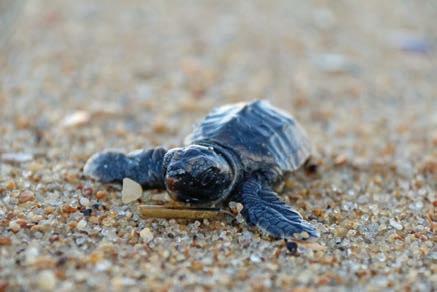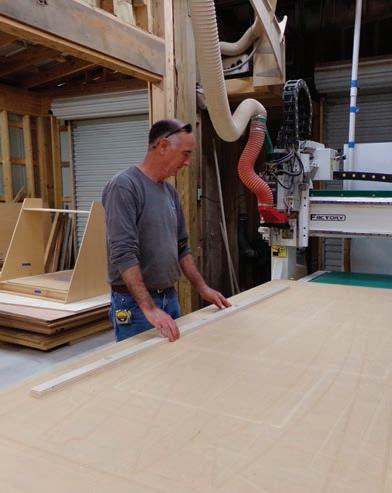
4 minute read
25 years
N.E.S.T. volunteers: Protecting sea turtles for over 25 years
by Summer Stevens
It’s just past sunrise when the ATVs begin their slow trek along the quiet beaches of the Outer Banks, volunteers scanning the shoreline for the delicate sea turtle nests that appear in late spring and into the summer. Though the rental houses are packed, there’s only a few early risers on the beach at this time in the morning, not enough to obscure the turtle crawls, which look like tractor tire tracks in the sand.
The driver slows and spots evidence of a nest. He peers into a depression in the sand about twenty inches deep, gently brushing away the sand to reveal dozens of small white eggs. Sea turtles lay between 100 and 120 eggs every two to three years, laying three to four clutches of eggs in a season. The mother sea turtle is nowhere to be seen. A healthy adult sea turtle only comes ashore to lay her eggs, then retreats back into the ocean, leaving her tiny offspring to fend for themselves.
There are many dangers facing the ping pong ball size eggs. Sea turtle nests are vulnerable to predators like birds, ghost crabs, dogs and foxes. Ocean overwash can destroy the nests. Light pollution also affects the hatchlings, who naturally head toward the brightest horizon. Artificial light can confuse them and make it difficult to reach the ocean.
So in 1995, the Network for Endangered Sea Turtles (N.E.S.T.) was founded by Millie Overman, with the purpose of protecting sea turtles from the Virginia line to south Nags Head. According to the organization’s website (www.nestonline.org), “N.E.S.T. is committed to contributing to the preservation of these species through research and rescue and rehabilitation efforts and to fostering greater understanding and appreciation of these species and their habitat through education and enhanced public awareness.”
N.E.S.T. is an all-volunteer organization, with 300 people currently serving in areas including ATV nesting patrols, nesting response, nest sitting, stranding response, rehabili tation,
Photos courtesy of N.E.S.T.

public education, fundraising, communications and board of directors.
“We receive a great amount of support from our OBX community!” said director-at-large Christian Legner, who has been volunteering with N.E.S.T for 14 years. “From visitors to locals to businesses we enjoy seeing initiatives like Skip The Straw and beach cleanups help to conserve sea turtles and their habitats.”
Though N.E.S.T. does not reveal the location of the nests to the general public, the eggs are well protected. When hatching time draws near – about 60 days – volunteers will quietly sit beside the nests in the evening, protecting the nests from predators and from light pollution. The goal is to make sure as many hatchlings as possible reach the ocean. N.E.S.T. volunteers typically care for 10 to 20 nests in a season.
Ensuring the hatchlings’ safe passage to the surf is not the only goal of N.E.S.T. From the organization’s inception, they have been rescuing injured and sick turtles, with the goal of rehabilitation and release back into the wild. In the 1990s, because there was no facility to treat injured turtles, according to the N.E.S.T. website, “The first injured turtles were treated in the living rooms of N.E.S.T. volunteers.” A facility was eventually built at the North Carolina Aquarium on Roanoke Island, and in 2014, that facility was upgraded to the Sea Turtle Assistance and Rehabilitation (STAR) Center, where N.E.S.T. volunteers still care for the turtles.
N.E.S.T. receives hundreds of calls a year from community members and tourists who have spotted sea turtles. The organization screens and investigates each call, transporting injured turtles to the STAR Center. In the winter months, N.E.S.T. rescues turtles stunned by the cold water and stranded in the Pamlico Sound. Many of these turtles are also taken to the STAR Center for care.
In 2021, N.E.S.T. will continue its mission to care for sea turtles, coming together as a community to protect these unique creatures. “Anyone and everyone can help marine animals and their habitats,” Legner said. “Small changes, no matter where you live, make a difference!”



UNIQUE Event for Your Group Meeting
BOOK PRESENTATION AND/OR SIGNING Featuring "America's Forgotten Heroes," The United States Life-Saving Service, direct predecessor of today's U.S. Coast Guard. FREE BOOK SIGNING-ONLY EVENT! For reservations, email Keeper JamesLSS@gma1l.com Or call 252-996-0493 There are five species of sea turtles. Not all nest on Outer Banks beaches, but all can be found in our waters: Loggerhead (threatened) Green (threatened) Kemp’s ridley (endangered) Leatherback (endangered) Hawksbill (endangered) DID YOU KNOW? Sea turtles can be cute, but they are wild animals. They aren’t used to being close to humans and will typically avoid interactions. All species have strong jaws and flippers and their power should be respected. A mother sea turtle might abandon her nest-laying activities if bothered by lights, noise or approaching people. If you see a stranded sea turtle, call (don’t email or Facebook message) the N.E.S.T. hotline at 252-441-8622. HOW YOU CAN HELP PROTECT SEA TURTLES: Reduce marine debris, especially single use plastics. Limit light on the beach during nesting and hatching season by turning off ocean-facing lights and closing blinds. Remove beach furniture overnight and fill in holes during the day. Call the N.E.S.T. hotline if you spot a stranded sea turtle, nesting females or hatchlings. Be a N.E.S.T. volunteer! Training information is available on their website (www.nestonline.org).












